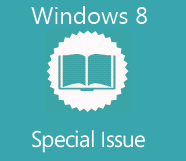| The Microsoft journal for developers | OCTOBER 15, 2012 VOL 27 NO 10A |
 |
 |
The Windows Runtime is at the heart of creating Windows Store apps. Learn how it provides a powerful platform on which to create these new apps, with a development surface that’s rich in functionality and consistent and thoughtful in design.
Jason Olson
.jpg) Modern Apps:
Modern Apps:
The Windows Store App Lifecycle
You’ll want to understand the nuances of the new WinRT application lifecycle so you can build apps that respond as they should at every point. Rachel Appel explains the different stages.
Rachel Appel
Features
Windows Runtime and the CLR: Underneath the Hood with .NET and the Windows Runtime
A look at how the CLR enables managed developers to talk to the Windows Runtime, exposing Windows Runtime APIs as if they’re just another managed class library for .NET developers to use.
Shawn Farkas
Windows Runtime Components: Windows Runtime Components in a .NET World
Jeremy Likness walks you through the requirements needed to create a Windows Runtime Component in C#, how to reference and use it, and how it impacts other language selections when developing Windows Store applications.
Jeremy Likness
Columns
Azure Insider
Windows 8 and Microsoft Azure: Convergence in the Cloud
The inaugural edition of our Azure Insider column describes how to build a simple cloud-hosted service to support asynchronous clients, then shows you how easy it is to call into a Web service from a Windows Store application to retrieve data.
Bruno Terkaly
Ricardo Villalobos
Editor's Note
All Eyes on Windows 8
Welcome to the Windows 8 special edition of MSDN Magazine.
Michael Desmond
Silverlight and WPF: Writing Silverlight and WPF Apps with Windows Runtime XAML in Mind
Business developers will continue to build new Windows Presentation Foundation and Silverlight applications in the years to come. This article shows you what you can do to make porting, reuse or dual targeting reasonable when considering Windows Store applications.
Pete Brown
MVVM: Using the MVVM Pattern in Windows 8
The Model-View-ViewModel (MVVM) design pattern achieves a separation of logic and UX in Windows Store applications and also enables UX designers to create and test UIs without the existence of the underlying logic. Learn how to create an application using the MVVM design pattern in Visual Studio 12, using the MVVM Light Toolkit.
Laurent Bugnion
XAML and C++: Introducing C++/CX and XAML
Learn how to take advantage of a modern, XAML-based UI framework in C++ to build Windows Store apps.
Andy Rich
Windows Runtime and C++: Porting Desktop Applications to the Windows Runtime
Diego Dagum discusses how to port C++ desktop applications to the Windows Runtime Library, using a sample calculator application as a practical example.
Diego Dagum
JavaScript: Managing Memory in Windows Store Apps
Users today want to rapidly switch among multiple apps to accomplish tasks, and they expect their machines to keep up. Learn how to identify, diagnose and repair memory leaks so you can be sure your Metro style app will give users the experience they’re looking for.
David Tepper
JavaScript: Data Binding in a Windows Store App with JavaScript
Learn how the JavaScript framework for building Windows Store apps and the underlying Windows Runtime allow you to build apps with client-side state, offline storage, controls, templates, binding and much more.
Chris Sells
Brandon Satrom
Design and UX: Authoring Windows Store Apps in Blend
Explore how Expression Blend for Visual Studio 2012 can be used to create UIs for Windows Store apps using XAML or HTML. Examples show the Blend Device panel, CSS editors, data template editing and interactive mode.
Christian Schormann
Online-only Features
Web Dev Report: Integrating jQuery Mobile into ASP.NET Web Forms and MVC Web Apps
This month, Rachel Appel explains how jQuery Mobile can make it easier for you to “go mobile” with your new or existing ASP.NET Web Forms or MVC Web apps.
Rachel Appel
Azure Insider: Running Any Workload at Scale
Find out how you can use Azure with Linux systems to run workloads that offer powerful capabilities.
Bruno Terkaly
Richardo Villalobos
Kinect: Working with Kinect Studio
Find out how you can use Kinect Studio to capture data feeds, save them as .xed files and reuse them to test your Kinect-enabled apps.
Leland Holmquest
Team Foundation Server: Using PreEmptive Analytics for Team Foundation Server for Rapid Feedback in Production
Learn how to leverage the built-in features of Team Foundation Server to integrate incident reports and other data into existing workflows, so teams can respond more rapidly to issues and events in production.
Chris Kinsman












